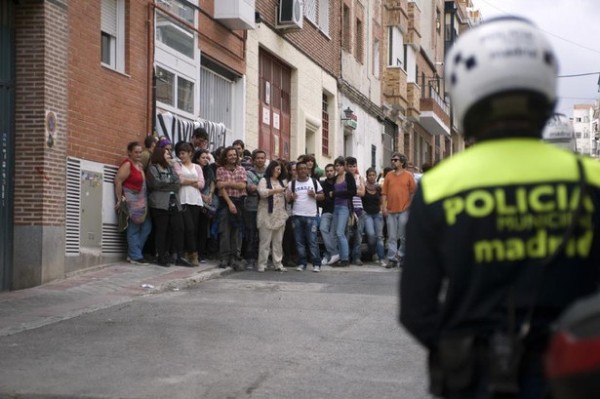- Ter Garcia and Diego Sanz Paratcha
November 18, 2013
What makes a movement turn into a landlord?
Over the past two years in Catalonia, Spain, more than 700 people have made empty houses owned by banks their new homes thanks to the support of the Platform of People Affected by the Mortgage, or PAH. In Andalusia, another 400 people have used a similar strategy to re-appropriate bank-owned buildings.
The idea of a large-scale public takeover of empty buildings to house evicted people, or people under threat of eviction, began to develop in the summer of 2011 among members of PAH, using the faux bureaucratic moniker of “Social Program.” Already, over the past several years, PAH had been successful in preventing evictions and renegotiating mortgages. But it wasn’t until this past June, during a meeting held in Valencia, that local chapters of PAH decided to make the building-takeover effort a priority.
The first two buildings targeted by PAH in Catalonia were occupied after a large housing-rights demonstration in December 2011 in Terrassa, a city near Barcelona. These two empty buildings, owned by Caixa Catalunya and BBVA — two of the largest banks in Spain — have since housed 16 families. The families asked the owners to allow them to pay subsidized rent, and most of them are waiting for a reply. But those buildings were only the beginning. In the following months, another 11 buildings were occupied by nearly 50 families in Barcelona and Girona with the support of PAH.
Some months before that, people in Andalusia had already begun their own campaigns for housing rights. They are not members of PAH, but the objective and the strategy was the same: squat in empty houses owned by banks and ask for subsidized rent. In June 2011, 11 families (including 20 children) squatted in a building in Málaga, which began the corralas movement — named after a traditional Spanish building with a central courtyard that neighbors share. Sixteen corralas have become home to nearly 250 families in Seville and Málaga, according to activists, but this is just part of a broader movement. In other areas of Andalusia, such as Bollullos del Condado — an area marked by deep social inequality — at least 500 people have been living in squatted communities since last June.
“We have contact with these families, but they organize on their own,” said Juanjo García, a member of the housing committee of the 15M movement in Seville, which arose from the encampments of mid-2011. “There are 269 squatted houses in three zones, and they will fight for their rights.”
Some weeks ago in Valencia, another building was recovered by members of PAH, who gave it the name of L’Esperança, which means “hope.”
“It is a building that was empty for a year and a half,” said Celes Navarro, a PAH member. Now, the building is home to six families, as well as the meeting place for PAH activists in the city.
Life in a squatted building is not easy. Most of the corralas in Andalucia have no water or electricity, explained Juanjo. One of them, Corrala Utopía, managed to get running water turned back on by the city council after it was cut off by the municipal water company. Still, a fountain is the only source of water for the more than 100 people living there. The situation is similar in the other corralas— with the exception of La Libertad, where families negotiated with the owner of the building a rent of 600 euros per month for the entire building. Several occupied buildings have been evicted, and in most of those cases the families are facing criminal charges.
Pilar Rodríguez, one of the lawyers who works with PAH, admitted that the legal strategy of the movement “is still at an initial stage.” Most of the work during the past few months has focused on developing a manual on squatters’ rights, but at the moment there is no offensive legal strategy. “We are thinking about looking for pronouncements from international agencies and centering the offensive on the lack of alternatives that those who are evicted face,” said Rodriguez.
So far, the courts’ response to the squatted buildings has been encouraging for activists. One of the three court cases against the squatters in the city of Sabadell has been thrown out. Other courts have refused the petitions of eviction of another building owned by the bank Sareb, asserting the right to housing over the right to property.
October 16 was slated to be the day of the eviction of another of the squatted buildings near Barcelona, in Salt. There were 46 people living there, 21 of them under 18 years old. Popular support was considerable for the families of the Sareb-owned building; 38 Catalan legislators asked police to disobey the eviction. The night before the planned eviction, dozens of people came to the building to support the families, and 100 firefighters announced that they would join the fight to stop the eviction. When the day came, the European Court of Human Rights ordered that the eviction should be postponed until the end of the month and urged the Spanish government to provide alternative housing to the families.(The families are now waiting for the court to choose a new date for the eviction.)
At this point, 34 participating families have secured subsidized rent after squatting in an empty house, and more than 150 are negotiating with banks. Their accomplishments, together with the order of the European Court, are steps toward ensuring that the right to housing trumps the interests of the banks.






